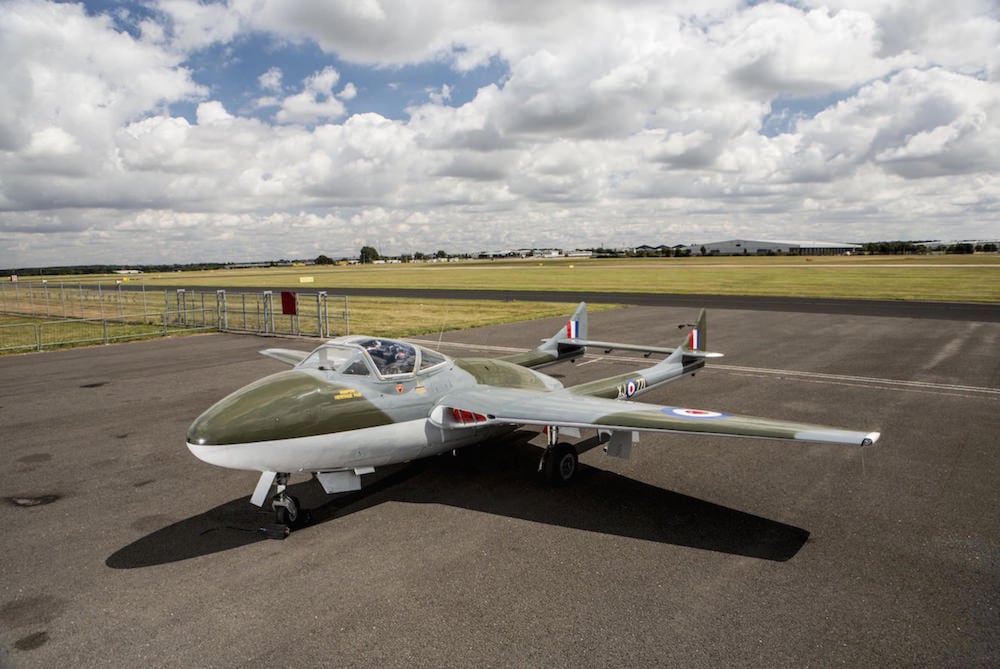
de Havilland Vampire Offical Website of Clacton Airshow
The prototype DH100 Vampire (LZ548/G) was first flown on 20th September 1943 at Hatfield by Geoffrey R de Havilland (son of the founder), albeit some 6 months after the Meteor, having been delayed by engine availability. The first production DH Vampire (F.1) was actually produced by the English Electric Company at Warton due to the production.

De Havilland DH100 Vampire FB9 Rhodesia Air Force Aviation Photo 1702929
Designed during World War 2, the de Havilland Vampire would go on to become a strange looking but effective single engine jet. A multirole aircraft, it would.

Interesting facts about the de Havilland Vampire; The Second Jet Fighter of British RAF
The de Havilland Vampire was the first true design for a British jet fighter plane. That demanded a completely new classification of the individual assemblies to each other. Frank Halford had designed a jet engine, called H 1 and later Goblin, with a thrust of about 2,530 lb (ca. 1,148 kg). The aircraft designers found this sufficient for a.

1958 De Havilland Vampire T55 Jet Uncrate
The Vampire was first powered by a Halford H1 (later called the "Goblin") producing 2,100 lbf (9.3 kN) of thrust, designed by Frank B Halford and built by de Havilland. The engine was a centrifugal-flow type, a design soon superseded post-war by the slimmer axial-flow units. Initially, the Goblin gave the aircraft a disappointingly limited.

De Havilland DH115 Vampire T11 Vampire Preservation Group Aviation Photo 1734546
The de Havilland DH.100 Vampire held two key distinctions concerning aviation history - she was the first jet-powered aircraft anywhere to land on a moving aircraft carrier (this completed in her navalized "Sea Vampire" prototype guise) and she was the first jet aircraft in British service to be powered by a single turbojet engine - the previous attempts all fitted engines in pairs due to.

de Havilland Vampire Jet
De Havilland DH 100 Vampire Mk 3. The Vampire began as an experimental aircraft, with design work beginning at the de Havilland works in 1941, with the first flight at Hatfield in September 1943. The aircraft was entirely a de Havilland project, and it utilized the company's extensive experience with using moulded plywood for aircraft.

DE HAVILLAND VAMPIRE Tangmere Museum
The de Havilland Vampire was designed as a jet fighter for the British Royal Air Force in the late 1940s (RAF). Son of the company's creator, Geoffrey de Havilland Jr., and his team at de Havilland's Hatfield facility designed it. The Vampire was intended to be a smaller, less complex alternative to the earlier Gloster Meteor..

De Havilland Vampire Aircraft Wiki FANDOM powered by Wikia
The de Havilland DH.100 Vampire was a British jet fighter commissioned by the Royal Air Force during the Second World War. Following the Gloster Meteor, it was the second jet fighter to enter service with the RAF. Although it arrived too late to see combat during the war, the Vampire served with front line RAF squadrons until 1953 and continued in use as a trainer until 1966, although.

Interesting facts about the de Havilland Vampire; The Second Jet Fighter of British RAF
In developing the Vampire, de Havilland applied its expertise in wood construction to manufacture a fuselage of the same type of plywood/balsa wood sandwich used in the Mosquito. The Vampire's twin-boom configuration enabled the jet tail pipe to remain short in order to extract as much thrust as possible from the somewhat low-powered engines.

Wallpaper Fighter, Vampire, RAF, De Havilland Vampire, Combat training, de Havilland Aircraft
de Havilland Vampire T.35 ( A79-612) in Wagga Wagga, New South Wales, Australia. Vampire bearing Lebanese colours at Hatzerim, Israel. Swiss Air Force Vampire at Letecké muzeum Kbely. T.55 of Japan Air Self-Defense Force at Hamamatsu Air Base public hall.

De Havilland (FFA) DH100 Vampire FB6 Untitled Aviation Photo 2828080
PERFORMANCE: Max speed 538 mph. Cruise speed 316 mph. Range 840 nm. Ceiling 40,000′. The twin-tailed Vampire was too late to see service in World War II, but quickly became Britain's home defense fighter. By 1951 the Vampire was being replaced by the Meteor, so in 1950 de Havilland offered a twoseat training version of the jet.

DE HAVILLAND VAMPIRE JET Recovery Curios
The De Havilland Vampire was the RNoAF's first jet fighter. Between May 1948 and April 1951 a total of 20 F Mk. II and 36 FB Mk. 52 Vampires were supplied to Norway. In the summer and autumn of 1952 six two-seat training version Vampires T Mk.55 were delivered to 336 and 337 Squadrons. After a vain attempt to sell the remaining aircraft in.

de Havilland Vampire Jet
Designed at Salisbury Hall, and built and first flown at Hatfield in 1943, the Vampire single-seat fighter was the first de Havilland jet aircraft. It is of compact pod and twin-boom design, with a single DH Goblin centrifugal turbojet behind the cockpit, fed by wing-root air intakes. Given the modest thrust of the early turbojets, this.

Clasp Garage de Havilland Vampire
The prototype DH 113 Vampire NF10 G-5-2 takes off for the first time on 28 August 1949. The night fighter DH Vampire variant was a two-seat, private venture of the DH100 Vampire built by the De Havilland Aircraft Company during the late 1940s. It was allocated the designation DH113 before ultimately leading into the DH115 Vampire Trainer.

Interesting facts about the de Havilland Vampire; The Second Jet Fighter of British RAF
The de Havilland Vampire was a British jet fighter that was developed during world war 2. It entered service after the war, as the second jet fighter to be o.

de Havilland D.H.100 Vampire Specifications Technical Data / Description
The De Havilland Vampire is a jet-powered aircraft that played a significant role in the early development of jet aviation. It was designed and built by the British aircraft manufacturer De Havilland during the late 1940s and early 1950s. The Vampire was one of the first successful jet fighters and served in various roles with multiple air.